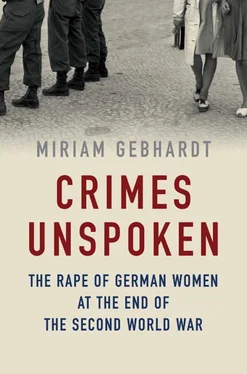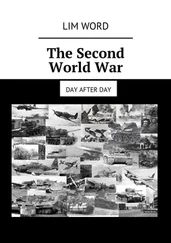The Russian officer’s warning turned out to be true. In her memoirs, Leonie Biallas graphically describes what happened to her trapped in the city and paints a terrible picture of the encounter between a naïvely innocent girl in pigtails and a fearful Red Army soldier with a black beard, bushy eyebrows and a fur hat:
He grabbed hold of me and dragged me towards a door. I tried to escape, struggled desperately. My mother attempted to come to my aid and pull me from him. He pushed her away and opened the door. It led to the bathroom. Mother tried to come in as well. He slammed the door shut and bolted it. He was out of his mind and tried to pull my trousers down but couldn’t undo the fastening. He pulled out a knife. I screamed. Now he’s going to stab you, I thought. Mother hammered on the door from outside and also screamed. The soldier cut the belt with the knife and pulled off my trousers and underwear. Then he forced me down onto the stone floor. I hit my head. He threw himself on top of me. I was frozen and didn’t even scream any more. But mother continued to moan all the time behind the door. I don’t think it lasted very long. He stood up and left the bathroom and house without a word. I squatted on the cold floor and just wanted to crawl away into a corner. Mother came in, took me in her arms and comforted me. We were both crying. [22] Ibid., pp. 19–20.
This was just the beginning of the torment suffered by Leonie, her mother and her aunt Gertrud, who was over 60 years old, along with the nuns in the nearby nunnery, or a 16-year-old girl who bled to death as a result of the rapes. Some women deliberately stuck to officers so as to escape the ‘stinking lice-ridden’ ordinary soldiers. Such was the case with the mother of Ruth Irmgard Frettlöh. The girl saw her leave a shed with a commandant – smiling. The picture remained etched in her memory and for decades clouded her relationship with her mother. It was only much later that she discovered that her mother had only been so nice to the rapist so as to protect her daughter. [23] Ingeborg Jacobs, Freiwild: Das Schicksal deutscher Frauen 1945 (Berlin 2008), pp. 72–4.
This behaviour is a feature of many of the descriptions of rape while in flight: mothers sacrificing themselves for their daughters, daughters for their mothers or fathers. The violent acts produced a tangled web of lifelong family guilt. We read in the sources of cases in which elder siblings, from one moment to the next, had to look after the younger ones because their mothers were regularly taken away by Soviet soldiers both for sexual services and also for work of all kinds. They also had to provide information about the whereabouts of their husbands if the Soviets suspected them of being Nazis or war criminals. It doesn’t take much to imagine the moral dilemma of these women, who were exposed not only to sexual aggression but also to the threat of deportation.
One in five Germans has a refugee or deportation story in the family. [24] Albrecht Lehmann, Im Fremden ungewollt zuhaus: Flüchtlinge und Vertriebene in Westdeutschland 1945–1990 (Munich 1993).
The richest source of information about the situation at the time, the main official outlet for speaking and providing written testimony afterwards was the documentation produced by the Federal Ministry for Displaced Persons, Refugees and War Victims, which appeared from 1954. Today it forms an impressive and contemporary source of memories comparatively close to the time the events took place. Caution is nevertheless required in interpreting the reports. The aim of the documentation was to institutionalize the memory of flight and expulsion in order ‘to provide posterity with an authentic record of the terrible events in Eastern Europe at the end of the Second World War’, as it says in the introduction to the record. [25] Bundesministerium für Vertriebene (ed.), Dokumentation der Vertreibung der Deutschen , vol. I/1, p. 23.
This ‘historically motivated official government task’ was directed by a high-level academic commission led by Theodor Schieder, who like his colleague Werner Conze was a highly respected historian of the time, but who has since been discredited on account of his Nazi sympathies. In the absence of other sources, the historians relied mainly on subjective recollections by the victims in their efforts to ‘raise the personal experiences of ‘flight and expulsion’ to the level of public memory culture’. [26] Mathias Beer, ‘Die Dokumentation der Vertreibung der Deutschen aus Ost-Mitteleuropa (1953–1962): Ein Seismograph bundesdeutscher Erinnerungskultur’, in Jörg-Dieter Gauger and Manfred Kittel (eds.), Die Vertreibung der Deutschen aus dem Osten in der Erinnerungskultur, Eine Veröffentlichung der Konrad-Adenauer-Stiftung e.V. und des Instituts für Zeitgeschichte (Sankt Augustin 2004) pp. 17–37; for discussion on the victims, see pp. 17–31, here pp. 21–2.
The commission studied the sources critically and, according to its own statement, devised a process for verifying the refugees’ statements. Those who look at the thick volumes today, however, will quickly note that they are a product of their time. In selecting eyewitnesses, no consideration was given to their earlier functions in the Nazi state. The texts are full of ideological stereotypes, with ‘Asiatic hordes’ and ‘monsters’, and German compatriots who remained faithful to the bitter end. Among the attitudes typical of the time was the condescension towards Poles and Russians. There are repeated references to ‘Polackenweiber’ and ‘hideous diabolical Mongol faces’. [27] For discussion of the documentation, see Robert G. Moeller, War Stories: The Search for a Usable Past in the Federal Republic of Germany (Berkeley 2001), pp. 51–87.
We must therefore take these stories with a pinch of salt. The documentation is nevertheless a terrible chapter in the history of women at the end of the Second World War.
Josefine S. [28] All names have been abbreviated in this book, even if they are named in the sources. In cases from very small villages or ones that are easily identifiable for other reasons, I have also changed the initials. I only give full names when the victims have published their stories under their own names.
from the district of Osterod [Ostróda] in East Prussia, now Poland, was surprised when she saw the first Soviet soldiers at the end of January 1945. She had been told that the enemy was nearly starved to death and was badly dressed, and yet she was confronted by strong and powerful young men and women soldiers bursting with health, all with good uniforms, felt boots and fur hats. And they all seemed to have joyful expressions on their faces. ‘They waved at us and called “Hitler kaput”, and for the first time I heard the rough and for us ugly sounding Russian language. We also saw the repellent faces of the functionaries.’ [29] Bundesministerium für Vertriebene (ed.), Dokumentation der Vertreibung der , vol. I/1, pp. 28–31.
One of the vehicles in the convoy stopped. Three tall soldiers got out, grabbed Josefine S. and threw her onto the vehicle. Her cries for help went unheard in the snowstorm. The car moved off again, and the icy wind blew around her. ‘One of the youths, who was lying wrapped in blankets, grinned as he observed me and asked “Cold?”’ The vehicle slowed down, and Josefine S. jumped out, but she was immediately grabbed again and lifted back onto it. There followed ‘the most degrading moments’ of her life.
At some point she managed to get away. She was up to her calves in soft snow. Help me, please God, was all she could think. Then she decided to accept ‘the fate she had been abandoned to’ and headed for a cow stall, where she found around 100 other people. Soldiers entered from time to time, including officers, and hauled out girls and young women. Crying and pleading were to no avail. The Red Army soldiers pointed revolvers at the women, grabbed them by the wrist and dragged them away. One father who tried to protect his daughter was taken out to the courtyard and shot. Then the girl was raped. ‘She came back towards dawn with fear in her child’s eyes. She had aged overnight. As her body was no longer capable of expressing her emotions, she sank down into the straw.’ Josefine S. heard a man saying that he wished he had poison to kill himself, his wife and his daughters.
Читать дальше











